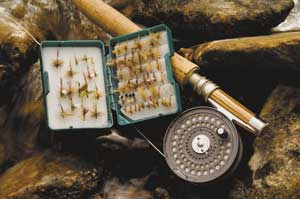
Ask any fly fisherman what his or her favorite season is, and more often than not, the answer will be spring. Spring not only offers the first chance of the year to fish dry flies, it also offers the best.
Spring is a magnificent reawakening. As the days grow longer and water temperatures rise, aquatic insects such as Mayflies and caddis flies begin to hatch. Lucky for us, trout like to eat them.
Here are some tips regarding dry-fly presentations that will help you catch more trout this spring:
1. Use the lightest fly line, leader and tippet you can handle for the conditions.
Using a lighter-weight line will allow you to make more delicate presentations that don’t put feeding trout down. The same goes for the leader and tippet diameter.
A lighter tippet size will catch more fish than a heavier one not only because fish are less likely to see it, but it also allows for the natural action of the fly on the water.
2. Avoid “drag” on your fly.
Drag is caused by not having enough slack in the leader and tippet. Your fly should move and bounce on surface of the water naturally. It should also float at the same speed as the current.
If you are not sure if your fly is experiencing drag, compare the speed of your fly to another nearby object, such as water foam. They should travel in the current at identical speeds.
3. Never false cast over trout.
False casting does two things that will put a feeding trout down. First, if the line and leader are wet, false casting will spray the surface of the water with tiny water droplets that will ultimately spook fish. Second, the movement of the line overhead and its shadow also spook fish.
If false casting is necessary, don’t practice it directly over a feeding fish.
4. Wear clothes that blend into the background.
I am a professional outdoor photographer, so I like my models to wear bright, eye-catching colors when in and around the water. But if I am serious about catching fish, I will wear very drab green, brown, or beige clothing to help blend into the environment.
When there is no camera around, it is better to catch fish than to look good.
5. Always get as physically close as possible before making a cast.
Before making an ill-advised cast, ask yourself if it’s possible to position yourself closer to your target without spooking the fish.
The longer the cast, the more likely your drift will cross multiple currents and create unwanted drag on the fly.
6. Wade in the water as little as possible.
Walking through the water alerts trout to your presence. Waves, small or large, can be detected by fish and will put them down, especially in very still water.
If you must wade into the water to get into a better casting position, make your steps as small as possible and move slowly without banging rocks together on the stream bed.
Water conducts sound four times faster than air.
7. Make downstream casts.
Since trout position themselves facing into the current, the conventional approach has always been from the downstream position casting upstream to feeding trout. This works fine at smaller streams with a faster current. But when faced with feeding trout in slow, shallow water, an upstream cast can put fish down by casting over the top of them.
Try getting a casting position upstream, assume a low profile, and make a downstream presentation so that the fly reaches the fish before the leader and tippet.
A reach cast or parachute cast are excellent downstream presentations that offer the fly drag free.
8. Fish the foam.
In most moving water channels, there are many currents moving at different rates of speed.
Currents with a foam line will have a higher concentration of food sources than others without foam. The trout will be where the food is.
Of course, there are exceptions to every one of these tips.
But nine times out of ten, these recommendations will improve your dry-fly presentations and help you catch more trout this spring.
They work for me.



Be the first to comment